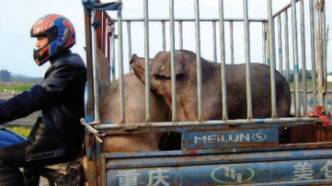Native pig breeds of China

Not only is China the place where half of the world’s pigs are bred, it’s also the country where a large number of relatively unknown pigs originate, having different characteristics and features. A short introduction into several Chinese species…
Pigs were domesticated from wild boars in several independent locations around the world around 7,000-9,000 years ago. In China, domestication of pigs occurred in a few separate locations at this time. The various native Chinese pig breeds were bred over time for important desirable traits such as fatty carcases with lard deposition, and good foraging appetite and outdoor hardiness.
TaiHu cross pigs on the way to the market
More recently, around 1900, there were extensive introductions into China of leaner European breeds, via the Russian, British and German colonies with improvement and breeding programmes continuing throughout the 20th century. In the last ten years there has been an explosive increase in imports of improved lean western breeds, due to the expansion of urbanisation in China and an associated uptake of leaner western-style pork.
A bit of history
The West had considerable interest in Chinese native breeds in the 1800s; imports of white Chinese pigs into Europe lead directly to the cross-breeding and improvement of ancient European breed lines becoming quickly popular among farmers and the public. Genetic and historical evidence suggests that three main lines of Chinese pigs were imported into Europe in the 1800s, via the Guangzhou and Macau ports.
These Chinese exports are usually identified as the white, black and tawny pig lines, and led particularly to the current Middle White and Large White (Yorkshire) breeds. Interest in the Chinese native breeds was raised again in the 1970s and 1980s when recognition of some of their special fertility characteristics lead to imports into the USA and Europe of high-fertility pig breeds such as the Chinese TaiHu Meishan.
These later became incorporated into some well-known commercial lines such as the Meidan. Plus ça change, plus c’est la même chose – or: the more things change, the more they are the same.
Native breeds
It is estimated that there are 48 native breeds remaining in China, which fall into various groups.
The TaiHu pigs have exerted a fascination over many western pig breeders because of their high fertility, excellent mothering ability, placid nature and extra teats. They originate from the TaiHu valley, which borders the major pig raising area of Zhejiang and Jiangsu provinces near Shanghai, also known as the Lower Changjiang River Basin.
TaiHu pigs have a big head, and a wide forehead with thick and wrinkled skin. They have big droopy ears and mouth flaps, and eight or nine pairs of teats. They are slow-growing with the average body weight at six months of age only being 48 kg. Average ovulation numbers in adult sows are 22 and litter sizes at the first, second and third farrowings are around 12, 14, and 16.
Scale
The scale of the local native or fatty pork market in China should not be underestimated – over 3 million hams derived from Jinhua pigs alone are sold annually. There are around 300,000 TaiHu sows in Jiangsu province, which is 20% of all sows raised in that province. The widespread backyard farm segment in China tends to produce many fatty local-breed pigs, sold to local markets, especially in more rural areas. Also, Xiang pig roasts and fatty pork cuts retain a clear and notable presence in small stores, restaurants and supermarkets throughout Chinese cities. In Shanghai, market share of traditional local meats went from 24% up to 60% during 1993 to 1998, when prices for western-style pork rose.
Besides backyard farms, some larger native breeder operations exist, which carry the most popular breeds. For example, several Zhejiang breeding centres have 400 Jinhua sows each; the Suzhou City centre breeding farm offers both meat breed sows, such as SuTai and mothering TaiHu sow breeds such as the Meishan and Fengjing. In these and many more centres, local breed sows are cross-bred to form new lines, such as a TaiHu/Duroc cross production pig line. This latter pig has proved to be a popular cross-breed, with much improved weight gain (body weight at six months is 86 kg), reduced back-fat, and improved lean carcase percentage.
Some of the naturally small hill breeds, such as Wuzhushan, have been taken up as ‘mini-pigs’ for medical research purposes, but their small size is often balanced by their hostile nature.
Native pigs and recent expansion
The native pig breeds have generally not formed part of the recent expansion/consolidation of the pig farm sector in China, including those expansions done with western partners. This is probably due to the lower prices and slow growth rates for native breeds, compared to improved western pigs, promising greater returns when sold into urban markets.
This has led to the reduction in herd size of some of the more obscure Chinese native breeds. Recognising this, the Chinese government has pioneered excellent conservation efforts for many of these rarer breeds, which are still greatly favoured by many – fatty pork was considered Chairman Mao’s favourite dish and we can highly recommend it.
Source: Pig Progress Volume 25 nr 3











